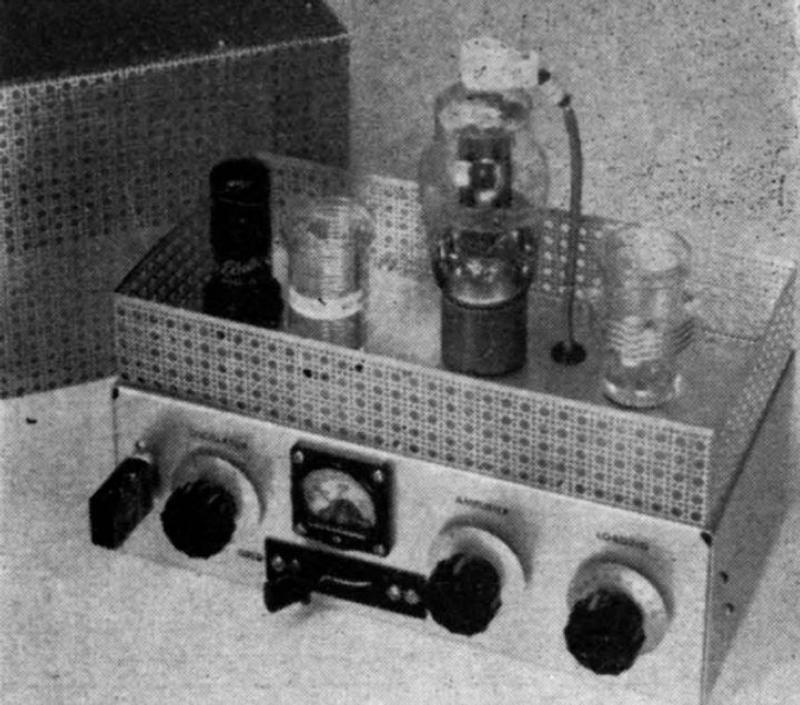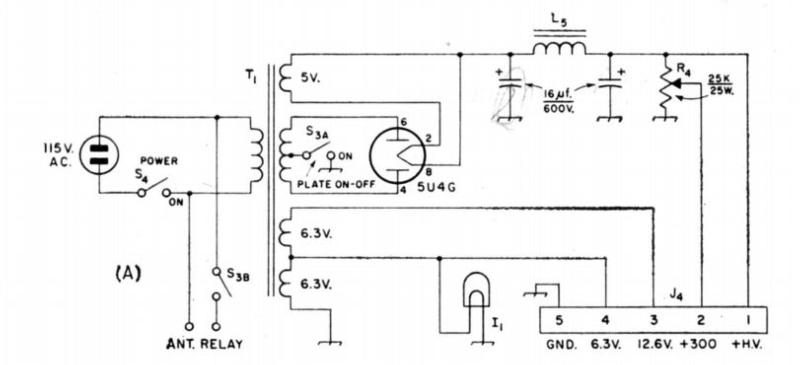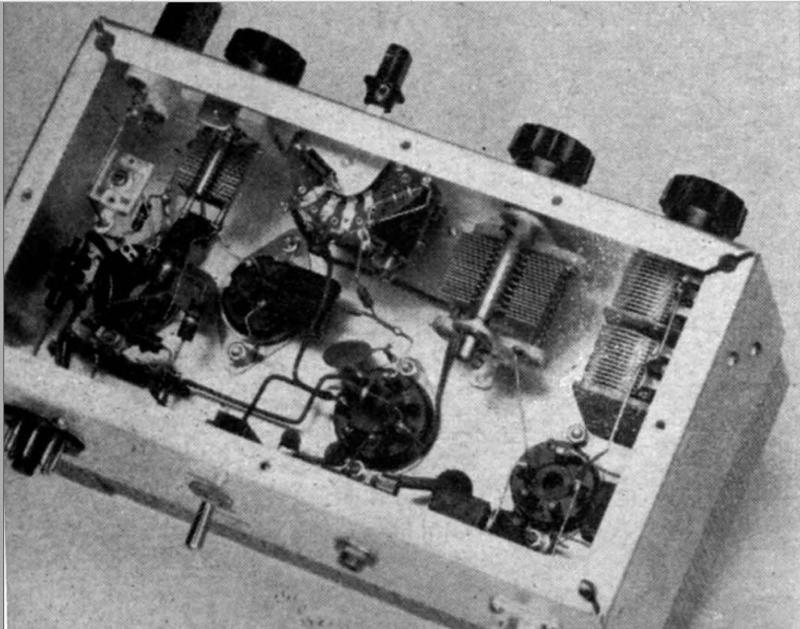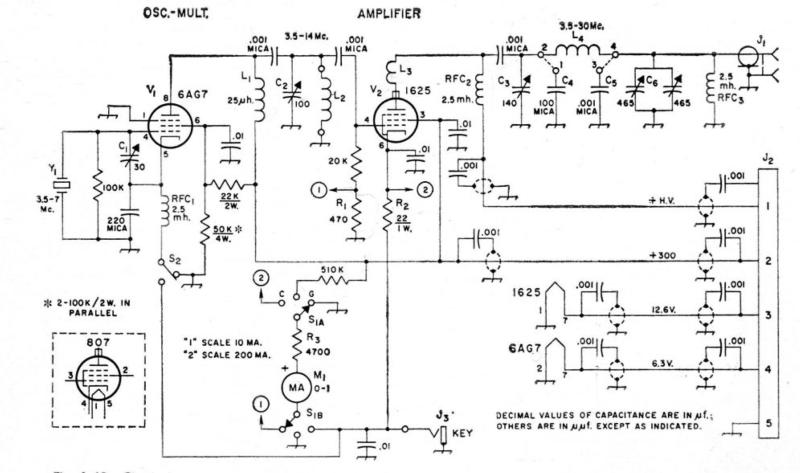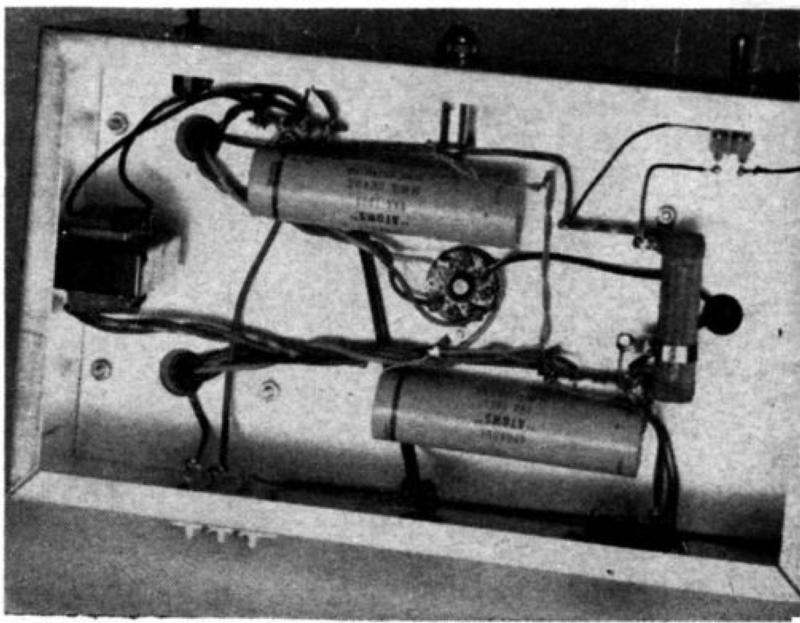
Posted By: Robert Nickels (ranickels) Posted: 07/09/2020 Vintage Ham Radio 07/09/2020 |
All Band Inexpensive 40 Watt Transmittera great "first homebrew xmtr" project |
|
Jay Miller KK5IM recently wrote an article in Electric Radio magazine about fulfilling his dream of building a homebrew "AM Kilowatt" transmitter (375 watts output by today's standards). His crystal-controlled exciter that drive the 813 was based on his Novice transmitter, which was built by his grand-uncle back in the 1960s when Novice class hams were lmited to less than 75 watts and crystal control. The design came from an 1961 ARRL Handbook article (attached below) called "All Band Inexpensive 40 watt Transmitter", that used the classic line-up of a 6AG7 oscillator followed by an 807 or 1625 PA. (The 1625 is identical to the 807 but has a 12 volt filament, which would require a different filament connection, but was commonly available for pennies from military surplus dealers at the time). This circuit would be an ideal "first homebrew rig" starting point because the parts are still inexpensive and not difficult to find (variable capacitors being the possible exception), it can be adapted to any ham band by choosing the right L-C values without the complexity of bandswitching, and it has everything needed to actually use on the air, including metering and provision for spotting the crystal requency with the receiver. (Back in the day of crystal control it was common to work "split" where each station tuned to the crystal frequency of the other). The coils described are made from cutting sections of "Air Dux" to the required length. Air Dux and similar coils were commonly available at the time and not expensive but today that's no longer the case. For the HF range, PVC pipe is a suitable coil form, or there are articles describing how to make the exact same type of self-supported air dielectric coils using a bit of plastic and glue. A very good article by W3JIP showing how this is done appeared in QST magazine and is also linked below. Thanks to the ARRL for making this needed information available! Hamfests and online sources will provide all the parts needed with a little patience. Hammond is the best source for new power transformers and chokes and while not inexpensive, making a separate power supply as shown makes it easy to use with future projects. One thing that isn't included is a T/R switch or relay to switch the antenna between transmitter and receiver and to mute the receiver during TX. I can solve that problem however! This is a perfect application for my VERSA-TR which was described in the December 2018 issue of QST and is available in kit from from Hayseed Hamfest. In addition to automatically sensing and switching the antenna, it can mute the receive audio and by connecting amplified type speaker(s) a pleasant sidetone is generated for CW monitoring. Hams have been using vacuum tubes longer than anyone but it's the guitar players who have kept tube manufacturers in business and amplifier builders that have provided companies with sufficient volume to keep making transformers and other components. So all hams wishing to re-live the golden age of building their own ham gear that is still very usable on the air need to do is take advantage of these sources and dust off a classic transmitter design like this one.
|
|
Related Images
Click on the image title or on the image itself to open the full-sized image in a separate window.
Related File Attachments
| Description | Comment |
|---|
Latest Articles
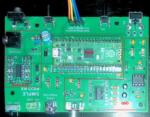
Technical
Posted: 01/29/2025
Comments: 0 |
Pico Rx performance - Excellent performance on 630m WSPR
The Simple Pico Rx is my minimalist implementation of Jonathan Dawson's "Pico Rx" at 101things: https://github.com/dawsonjon/PicoRX In this basic form the receiver consists of a Quadrature Sampling Detector (QSD aka Tayloe) and the Pico2 MCU which handles all DSP functions. There are NO front-end filters, the only bandwidth limitation comes from the tracking filter... READ MORE |
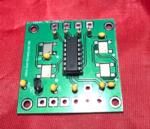
Crystal Replacement
Posted: 08/226/2024
Comments: 0 |
Making SMT "no lead" parts easier to use
SMT is the future - but how can we actually use parts without leads? ... READ MORE |
|
Crystal Replacement
Posted: 02/38/2024
Comments: 0 |
How good can a crummy receiver be?
Hundreds of different simple SDR receivers have been designed around Dan Tayloe's Quadrature Sampling Detector or QSD. Mine add nothing to the state of the art, and in fact subtract things, as I like minimalist solutions and the QSD is right in that sweet spot. Following the evolution of Tayloe's design I delete the resistors in series with the sample lines for inst... READ MORE |

Technical
Posted: 02/37/2024
Comments: 0 |
What's in a number (3253)?
The FST3253 dual four-to-one mux/demux IC has long been used as a "Tayloe Detector" or QSD (and QSE) in low-cost SDRs. They provide incredible performance for such a simple circuit, converting RF to baseband IQ with low loss and the ultimate in simplicity. Unfortunately the original FST3253 part has become obsolete and while substitutes are available, this is where the... READ MORE |

Vintage Ham Radio
Posted: 02/32/2024
Comments: 0 |
The Stancor 10P Transmitter
There weren't really many commercial transmitters in the 1930s as most hams built their own. But many of the ones that were offered came from the transformer companies who had two chances to profit. First, from those who would buy the kit, and two, from those would would see it in the (free) booklets the companies provided to their distributors who would then sell the iron to ham... READ MORE |

Vintage Ham Radio
Posted: 12/355/2023
Comments: 0 |
The Care and Feeding of the EF Johnson Courier amplifier
The EF Johnson "Courier" is a grid-driven amplifier using two 811A tubes. Switching is provided for operating in either class C for CW or as a class B linear amplifier for AM or SSB. Rated power is 500 watts input for CW, 500 watts PEP input for SSB, and 200 watts input for double-sideband AM with carrier. Since all amateur power levels were meas... READ MORE |

Historic
Posted: 11/329/2023
Comments: 0 |
TV Duplexer
Some things are interesting, even if totally useless nowadays. Such is the case with the Philco 426-3034 Crossover Kit for UHF TV. What the heck is that? Well, back in the late 50s, UHF television stations operating on channels 14-83 started to appear in many areas of the US where viewers had a VHF-only TV antenna, and in many cases an externa UHF converter was... READ MORE |

Crystal Replacement
Posted: 11/327/2023
Comments: 0 |
Replacing failed crystals
For decades, quartz crystals were used everywhere a stable frequency source was needed, even in some applications that depended on overtone (harmonic) behavior into the VHF range. These crystals were less stable and more dependent on circuit parameters that fundamental types and thus more problematic. Such was the case with the 94 MHz crystal in the 2 meter converter ... READ MORE |

Historic
Posted: 11/315/2023
Comments: 0 |
My Own Ham Radio Story by W9RAN
Everyone has a story of how they got involved in ham radio - this is mine. It started much earlier, including receiving a Knight Kit Span Master shortwave radio for Christmas in about 1963, at age 12. I'll never forget the night my dad and I finished building it and I wanted to try it out. It came with a 50 ft. antenna which was still coiled up - but ... READ MORE |

Technical
Posted: 09/267/2023
Comments: 0 |
Hot to simulate vacuum tubes in LTSpice
LTSice is a powerful simulation tool that is provided free by Linear Technology Corp. It comes with a complete library of passive and common analog solid-state components but if you want to use it to simulate vacuum tubes, it doesen't work as-is. Even though triode and pentode symbols can be found in the "Misc" folder, they are just schematic symbols and... READ MORE |
